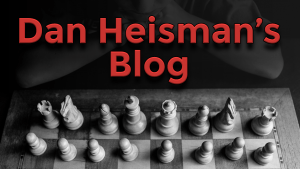Being a Good Tactician Requires Pattern Recognition AND Analysis
I've noticed that many inexperienced players believe that becoming a good tactician is primarily a matter of obtaining a large mental "database" of familiar tactical patterns, somewhat as they think becoming a good opening player means memorizing a lot of opening lines.
While there is no doubt that knowing many, many tactical patterns, especially the basic ones (see A Different Approach to Studying Tactics and Tactical Sets and Goals), is both necessary and a prerequisite for being an excellent tactician, this knowledge alone is not sufficient. Every excellent tactician, using this knowledge as a basis, is also able to analyze unfamiliar patterns to discover if clever tactics exist and, if so, to find and play them. Otherwise they wouldn't be excellent tacticians - those who could would be better.
It is the marriage of analysis and pattern recognition or, more generically, intelligence and knowledge, that allows for superior tactical ability. Sure, players like Morphy, Fischer, and Kasparov had the same inherent abilities the day they were born as they did when they later ruled the chess world, but it was both the development of those abilities (with regards to chess, and not, say, physics, as it was for Einstein) and their eventual familiarity with patterns (via tactical study) to build upon that made them so dangerous.
I can illustrate this point through two examples. I have given each to at least a hundred (probably more) students. The problem statement is on the caption under the diagram:
Example 1:
--------------------------------------------------------
All but the most basic beginners get this one correct: No, 1...Qxb5 is not safe because White can reply 2.Qh6 with the unstoppable threat of 3.Qg7#
This first illustrates the important point that chess does have unstoppable threats, so simply moving without anticipating dangerous replies (checks, captures, and threats) and waiting to see what the opponent will do can lose the game instantly if the opponent makes a winning threat that cannot be met. So each move you have to make sure the opponent does not have such a reply, and I have dubbed this "Real Chess" while failing to attempt to do so I call "Hope Chess" (see my first ever online article The Secrets of Real Chess).
However, for the purposes of this article, that's not the point. After my students correctly solved this easy problem I surveyed them, asking "Which of the following two choices best describes the primary method you used to solve this problem?"
- Recognizing a dangerous pattern and checking to see if indeed the danger was real (pattern recognition), or
- Raw analysis, where you didn't know the pattern but you looked around for dangerous replies to 1...Qxb5 and finally found the mating threat 2.Qh6, and then realized that in this situation that might be fatal?
For the next example, keep in mind the definition of safe:
A move is safe if it doesn't allow the opponent to forceably win material or checkmate (note: if you are losing badly it may easily be that no move is safe, but that's rather trivial).
Example 2:
...
...
...
...
...
...
...
...
...
...
...
...
...
...
...
...
...
--------------------------------------------------------
The answer is that 1.Nc3 is not safe because Black has the reply 1...Nb4, with a discovered attack of the pawn on d4 and a direct attack on the pawn on c2. Not only can't White save both, he has no way to save c2 by itself, so 1.Nc3 loses a pawn.
Almost everyone rated under 1800 gets this problem wrong or doesn't get it right for the correct reason (a few do get it correct for the right reason but, as noted, they are in a small minority). However, again that's not the point; that comes when I ask them "If you studied lots more tactics books, would that likely enable you to solve this problem because you would have seen many similar problems and recognize this pattern?"
Almost all my students agree with me that this is not the kind of problem that you find in popular tactic sets like best-selling tactics books or software sets like CT-ART (or even Chess.com's Tactics Trainer). Why? Well, for one reason the problem is not very sexy: you only win a pawn and you do so by simply attacking a pawn that can't be guarded! Who puts in tactics problems where the solution is that you can attack a pawn and it can't be guarded so you just win it? That doesn't sell books, nor fit in neatly with any tactics chapter like pins, double attacks (although this example does feature the unnecessary second attack on d4; c2 is lost even without it), removal of the guard, etc.
So it's not too likely that one would solve the problem with pattern recognition. It takes good old fashioned careful analysis to calculate that moves like 1.Nc3 are not safe. I asked one student, who lived in a metropolitan area, to give this position to a strong player at a local club and see what they would say. He located an IM who, when confronted with this problem in an even more watered-down form ("What do you think of 1.Nc3?"), reportedly paused a few seconds and, as expected, said "Well, if you play 1.Nc3, what do you do about 1...Nb4?"
It is likely this IM never heard of "Real Chess" or "Hope Chess" but international players are not in the habit of making moves without carefully checking to see if they are safe, using both pattern recognition and, if necessary, careful analysis. If they didn't, then even strong class players would beat them much more regularly just by making threats that can't be met. But the strong players, of course, do play "Real Chess" (although they probably don't call it anything) by making sure their moves are safe and doing their best to ensure such unstoppable threats won't exist. They would reject 1.Nc3 just as the IM did.
So the bottom line is that if you want to be a good tactician, then studying lots of tactics (starting with a heavy dose of basic tactics) is absolutely necessary and helpful. But if you don't augment that helpful knowledge with careful analysis deciding whether your moves - and your opponent's - are safe, then all that pattern recognition will only get you so far...






